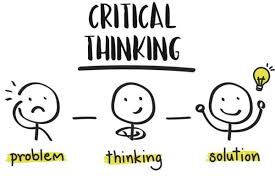What Is Critical Thinking
Critical thinking is careful goal-directed thinking. It is the process of actively and skillfully conceptualizing, applying, analyzing, synthesizing, and evaluating information to reach an answer or conclusion. A critical thinker can possess mindsets which could include:
- Ask relevant, clear questions with a precise and limited scope.
- Gather information and accurately assess it. Inquisitive and curious, and fair in their evaluation of evidence.
- Open minded and willing to have their beliefs challenged.
- Communicate with others in a productive, even-handed way that gets results.
- Questions everything, including existing social norms and traditions
- Consider all aspects of a problem and look at each element in its wider context. Avoid making assumptions.
Steps To Think Critically
Simple things that you can do to improve your critical thinking skills:
- Identify a specific problem that you’re working on. Break the problem down into smaller, more solvable ones.
- Ask clarifying questions. Ask questions about your beliefs and clarify assumptions.
- Evaluate prior efforts, looking at the problem through new lenses. Think the problem from different point of view like end user and developer. Focus on meaningful effort i.e. 80/20 rule. Mindful of your own biases. Situational factors influence our seemingly staple character traits.
- Reason through logic. Pay attention to the chain of logic constructed by arguments. Judge the arguments supported at every point by evidence. Consider causes and evaluate symptoms of the problem. Look symptoms from multiple perspective to figure out the root cause.
- Document all those findings into a clear and compelling problem statement. Look for solutions based on your findings. Think backwards to identify causes of the issues. Think forward to identify consequences of proposed recommendation. Solve root causes and not the symptoms. Learn from your and others experience.
- Once you have some solutions, focus on the meaningful. Evaluate all the possible solutions. Discard unworthy solution using 80/20 rule.
- Look at insights from the low level analytics that come back and take it up to the high road. Look for connections and patterns how this problem represents other ones you’ve solved. Also look for the unusual, the unexpected. Remove constraints to your thinking.
- Explore future implications of your solutions. Solutions can get a lot better by considering the impact of the choices we make.
- Diversify thought and collaboration. Get outside your personal bubble. Train yourself by talking to other people, it will help you escape your usual thinking and gain richer insights. Seek advice from other people.

Good Problem Statement
A clear problem statement is necessary for success. It defines the end goal and measure of success. A good problem statement :
- Outlines goal and charts boundaries. Defines the scope and requirement of the problem.
- Defines success criteria. Outlines the desired outcome from the proposed solution.
- Determine constraint and assumptions. Analyze the underlying assumptions and constraint which limit the scope of problem and solution.
- Identifies stakeholders who has deciding authority and give their insight.
- Establishes timeline. Break the solution into various milestone and come up with estimated deadline.
Common Pitfalls in Problem Solving
- Jumping to answers too quickly. You think you know what the problem is, and you rush off to solve it. To avoid that pitfall define well-scoped problem statement.
- Unwilling to expand the problem space. Think through what’s really causing that issue.
- Focus on things that don’t matter. Come up with a recommendation, and even though it’s insightful, it won’t really change the overall matrix. 80/20 rule will help to focus on results.
- Taking the analytical results at face value and just accepting. Look problem from high level.
- Not thinking through the future consequences of your solution. If you implement this, What will your competitors do? What are the new problems you’re going to cause?
- Stakeholders who are resistant to your idea. They’re going to put up the roadblocks, and it can be really frustrating. To overcoming that resistance, have set of facts that you’re going to base your assertions and your recommendations on.
